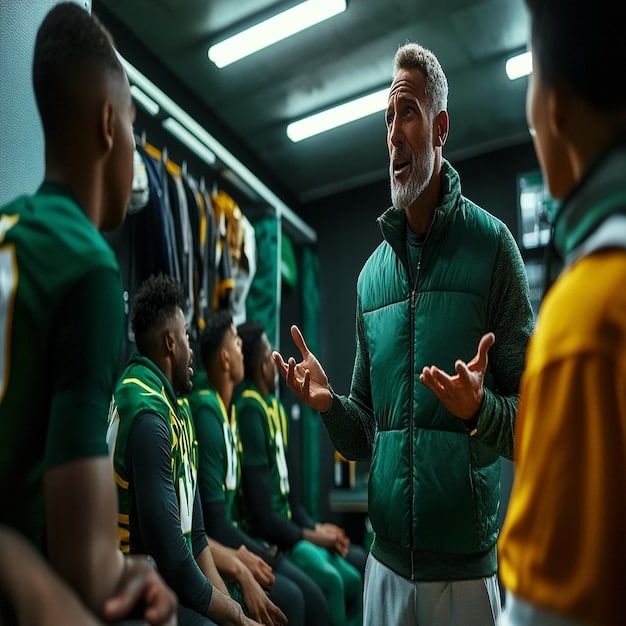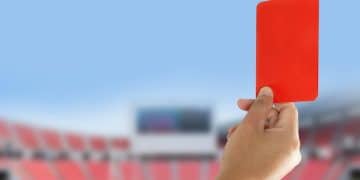FIFA’s Refereeing Standards in the US: Implementation and Evaluation

FIFA’s Refereeing Standards: How They’re Being Implemented and Evaluated in the US involve a comprehensive approach to ensure fair play, consistency, and accuracy in officiating games. In the US, these standards are integrated through training programs, performance assessments, and continuous improvement protocols.
The world of soccer relies heavily on fair and consistent officiating, and FIFA’s Refereeing Standards: How They’re Being Implemented and Evaluated in the US are critical to maintaining the integrity of the game. How are these global standards being put into practice here in the United States? What measures are in place to guarantee that referees are performing at their best, and how are they being held accountable?
Let’s dive into the specifics of how FIFA’s refereeing standards are implemented and evaluated in the US, shedding light on the processes, challenges, and ongoing efforts to enhance the quality of soccer officiating.
FIFA’s Refereeing Standards: An Overview
To understand the scope of implementation and evaluation in the US, we must first understand what FIFA’s refereeing standards entail. These standards cover a wide range of aspects, from knowledge of the laws of the game to fitness levels and decision-making under pressure.
Key Components of FIFA’s Refereeing Standards
FIFA’s standards are designed to ensure consistency and fairness across all levels of soccer. Here are some core components:
- Knowledge of the Laws of the Game: Referees must have an in-depth understanding of the 17 Laws of the Game, as defined by FIFA.
- Fitness and Positioning: Physical fitness is essential for keeping up with the pace of the game, and strategic positioning allows referees to have the best view of the play.
- Decision-Making: Accurate and quick decision-making is crucial, particularly in high-pressure situations.
- Teamwork: Referees work in teams – including assistant referees and video assistant referees (VAR) – requiring effective communication and coordination.
These standards are not static; they evolve with changes to the Laws of the Game and advancements in training and technology. FIFA provides comprehensive guidelines and updates, ensuring that referees worldwide are aligned in their approach to officiating.

In summary, FIFA’s refereeing standards establish a baseline for quality and consistency, setting the stage for how member associations, including the US Soccer Federation, implement and monitor these standards.
Implementation of FIFA’s Refereeing Standards in the US
The United States Soccer Federation (USSF) plays a pivotal role in implementing FIFA’s refereeing standards across various levels of soccer within the country. The USSF tailors these standards to the specific needs and context of American soccer, ensuring they are both relevant and effective.
Referee Training Programs in the US
The USSF conducts extensive training programs for referees, covering everything from the basics to advanced techniques. These programs are structured to ensure that referees at all levels have access to the knowledge and skills they need.
- Entry-Level Courses: These courses introduce aspiring referees to the Laws of the Game and basic officiating techniques.
- Advanced Training: Experienced referees can participate in advanced courses focusing on more complex aspects of officiating, such as game management and dealing with high-pressure situations.
- Continuous Education: Referees are required to participate in ongoing education to stay updated on the latest rule changes and best practices.
Referee Development Pathways
The USSF also provides clear pathways for referee development, allowing officials to progress from local leagues to national and even international competitions. These pathways include:
- Mentorship Programs: Experienced referees mentor newer officials, providing guidance and support.
- Performance Assessments: Referees are regularly assessed on their performance, with feedback provided to help them improve.
- Opportunities for Advancement: High-performing referees are given opportunities to officiate in higher-level matches, gradually progressing to more prestigious competitions.
In essence, the implementation of FIFA’s Refereeing Standards: How They’re Being Implemented and Evaluated in the US is a structured and ongoing process. It ensures that referees across the country are well-prepared and continuously improving.
Evaluation Processes for Referees in the US
Evaluating referee performance is an essential component of maintaining high standards, and in the U.S. several processes are in place to achieve this. These evaluations help identify areas where referees excel and areas where they may need improvement.
Methods of Referee Evaluation
A variety of methods are used to evaluate referees in the US:
- Game Observations: Trained assessors observe referees during matches, evaluating their positioning, decision-making, and game management skills.
- Video Analysis: Referees’ performances are reviewed using video footage, allowing for detailed analysis of their decisions.
- Feedback from Players and Coaches: Input from players and coaches is considered as part of the evaluation process, providing valuable insights into the referee’s performance.
Key Metrics for Evaluation
Evaluations focus on several key metrics to gauge referee performance:
- Accuracy of Decisions: How often the referee makes correct calls on fouls, offsides, and other game incidents.
- Consistency: The referee’s ability to apply the Laws of the Game consistently throughout the match.
- Game Management: The referee’s effectiveness in controlling the flow of the game, managing player behavior, and dealing with challenging situations.

The evaluation processes aim to provide referees with constructive feedback, helping them to grow and develop. Regular assessments and feedback loops ensure that FIFA’s Refereeing Standards: How They’re Being Implemented and Evaluated in the US are upheld consistently.
The Role of Technology in Enhancing Refereeing Standards
Technology has revolutionized many aspects of soccer, and refereeing is no exception. In the US, technology plays a crucial role in improving accuracy and fairness on the field.
Video Assistant Referee (VAR)
One of the most significant technological advancements is the introduction of the Video Assistant Referee (VAR). VAR involves a team of officials who review key decisions made by the on-field referee, using video replays to identify clear and obvious errors.
- Goals: Ensuring no incorrect goals are awarded.
- Penalties: Verifying penalty kick decisions.
- Direct Red Cards: Reviewing potential red card offenses.
- Mistaken Identity: Clarifying cases of mistaken identity in awarding cautions or sending-offs.
Goal-Line Technology
Goal-line technology is another tool used to ensure accurate decision-making, particularly in determining whether a ball has fully crossed the goal line. This technology uses sensors and cameras to provide instant confirmation to the referee.
Data Analytics
Data analytics are also becoming increasingly important in evaluating referee performance. By analyzing data on decisions, positioning, and other metrics, it’s possible to identify trends and areas for improvement.
Incorporating technology into refereeing helps maintain the integrity of the game. The use of VAR, goal-line technology, and data analytics contributes to more accurate and fair decision-making, aligning with FIFA’s Refereeing Standards: How They’re Being Implemented and Evaluated in the US.
Challenges and Future Directions
Despite the progress in implementing and evaluating FIFA’s Refereeing Standards: How They’re Being Implemented and Evaluated in the US, several challenges remain. Addressing these challenges is crucial for continued improvement.
Ensuring Consistency Across All Levels
Maintaining consistency in refereeing across all levels of soccer – from youth leagues to professional matches – is a significant challenge. Ensuring that all referees receive adequate training and are held to the same standards is an ongoing effort.
Adapting to Changes in the Game
Soccer is constantly evolving, with changes to the Laws of the Game and new tactical approaches. Referees must continuously adapt to these changes and update their knowledge and skills accordingly.
The Future of Refereeing in the US
Looking ahead, several initiatives could further enhance refereeing standards in the US:
- Increased Investment in Training: Providing more resources for referee training and development.
- Enhanced Use of Technology: Exploring new ways to use technology to improve decision-making and evaluation.
- Promoting Diversity and Inclusion: Encouraging more diverse participation in refereeing to better reflect the communities the sport serves.
Addressing these challenges and embracing future opportunities will further strengthen refereeing in the US, ensuring fair play and maintaining the integrity of the game.
| Key Aspect | Brief Description |
|---|---|
| ⚽ Training Programs | USSF offers extensive training for referees at all levels. |
| 🔍 Evaluation Methods | Game observations, video analysis, and feedback are used. |
| 🤖 Technology | VAR and goal-line technology aid decision-making. |
| 📈 Future Directions | Investing in training, tech, and diversity. |
Frequently Asked Questions
While the core standards are FIFA-mandated, implementation varies based on the specific soccer context in each country. The USSF tailors these standards to suit the needs and peculiarities of American soccer.
Challenges include maintaining consistency across all levels, accurately assessing subjective decisions, and providing constructive feedback that leads to improvement in high-pressure and fast paced scenarios.
VAR enhances accuracy by reviewing key decisions for clear and obvious errors. It ensures fairness in critical moments such as goals, penalties, and direct red cards providing an extra layer of oversight.
Mentorship programs pair experienced referees with newer officials offering guidance, support and practical advice aiding the development of skills and confidence. This helps in career progression.
Future steps include increased investment in training, enhanced use of technology, and promoting diversity and inclusion. These steps ensure standards remain high and equal for all involved individuals and teams.
Conclusion
In summary, the implementation and evaluation of FIFA’s Refereeing Standards: How They’re Being Implemented and Evaluated in the US are comprehensive processes designed to ensure fair play and consistency in soccer officiating. Through thorough training programs, rigorous evaluation methods, and the integration of technology, the USSF aims to maintain high standards across all levels of the game.
By addressing ongoing challenges and embracing future opportunities, the US can continue to strengthen its refereeing standards, ultimately enhancing the integrity and enjoyment of soccer for players and fans alike.





